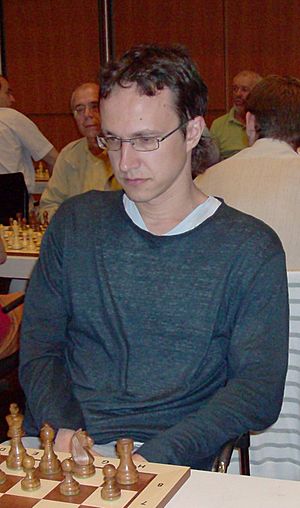Vadim Zvjaginsev facts for kids
Quick facts for kids Vadim Zvjaginsev |
|
|---|---|

Zvjaginsev in 2009
|
|
| Full name | Vadim Victorovich Zvyagintsev |
| Country | Russia |
| Born | 18 August 1976 Moscow, Russian SFSR, Soviet Union |
| Title | Grandmaster (1994) |
| FIDE rating | 2617 (December 2025) |
| Peak rating | 2688 (January 2012) |
| Peak ranking | No. 23 (October 2002) |
Vadim Zvjaginsev (born on August 18, 1976, in Moscow) is a Russian chess player. He earned the top chess title of Grandmaster (GM) in 1994. He was part of the Russian team that won gold medals at the 1997 World Team Chess Championship and the 1998 Chess Olympiad.
He studied at Moscow State University and finished his studies in 1996.
Contents
Becoming a Chess Star
Vadim Zvjaginsev started playing chess at a young age in Moscow. He quickly became known as one of the youngest "Candidate Masters of Sport" and then "Masters of Sport" in the USSR.
Early Wins
- In 1992, Zvjaginsev won the European Youth Chess Championship for players under 16.
- Just two years later, in 1994, he shared first place at the Reykjavik Open tournament.
Big Tournaments and Team Success
- In 1997, at the FIDE World Championship in Groningen, he surprised many by defeating several strong American players. He beat Joel Benjamin, Gregory Kaidanov, and Yasser Seirawan before losing in a later round.
- That same year, Zvjaginsev won the Vidmar Memorial tournament in Portorož.
- He also won the Essen tournament twice, in 2000 and 2002.
- In 2003 and 2004, he placed second at the Mainz Chess Classic.
- At the Russian Championships in 2005, he finished fourth in the Superfinal.
- In 2006, he tied for second place at the Poikovsky Karpov Tournament.
Playing for Russia
- In 2002, Zvjaginsev played in the special Russia vs Rest of the World match held in Moscow.
- He won the Russian Cup knockout tournament in 2011.
- In 2013, he tied for first place at the Chigorin Memorial in Saint Petersburg.
- In 2016, he tied for third place at the Aeroflot Open.
Team Medals
Zvjaginsev has won many medals in team chess events:
- In 1997, he earned team and individual silver medals at the European Team Chess Championship.
- At the 1994 Chess Olympiad, he helped the Russian second team win a bronze medal.
- He won two gold medals (team and individual) at the 1997 World Team Chess Championship.
- With the main Russian team, he helped win team gold at the 1998 Chess Olympiad and team silver at the 2004 Chess Olympiad.
Zvjaginsev's Chess Style
Vadim Zvjaginsev is known for his very aggressive and tactical playing style. This means he likes to attack and look for clever moves that surprise his opponents.
The famous chess player Viktor Korchnoi once said that Zvjaginsev is a very original player. His unique way of thinking shows in his chess games.
Surprising Openings
Zvjaginsev is famous for using unusual opening moves. These are called "opening novelties." He uses them to catch his opponents off guard and avoid common chess strategies. This makes the game a battle of wits right from the start!
For example, around 2005, he surprised the chess world with a new move against the Sicilian Defence. He played 1.e4 c5 2.Na3!?. He even used this move to defeat top Grandmasters like Alexander Khalifman and Ruslan Ponomariov, who were both former FIDE World Champions.
Amazing Games
Here are some examples of Vadim Zvjaginsev's exciting and clever chess games.
| This section uses algebraic notation to describe chess moves. |
This game shows Zvjaginsev's tactical style. He finds weaknesses in his opponent's position, leading to a winning attack.
Zvjaginsev (2635) – Seirawan (2630) [D63] FIDE WCh KO Groningen NED (3.4), 16.12.1997 1.d4 Nf6 2.c4 e6 3.Nc3 d5 4.Bg5 Nbd7 5.Nf3 h6 6.Bh4 Be7 7.e3 0-0 8.Rc1 a6 9.b3 b6 10.cxd5 exd5 11.Bd3 Bb7 12.Bf5 g6 13.Bh3 Re8 14.0-0 Nf8 15.Ne5 N6h7 16.Bxe7 Rxe7 17.g3 Qd6 18.Bg2 Rd8 19.Qc2 Ne6 20.Rfd1 Kg7 21.Qb2 f6 22.Nd3 Nhf8 23.b4 g5 24.Nc5 bxc5 25.bxc5 Qc6 26.e4 Red7 27.exd5 Rxd5 28.Nxd5 Rxd5 29.Rb1 Nd8 30.Qe2 Qd7 31.Rxb7 Nxb7 32.c6 Qxc6 33.Qe7+ Kg8 34.Qe4 1–0
In this game, Zvjaginsev made an amazing sacrifice of his knight, then an exchange, and even his queen! All of this was to force a checkmate against White's king.
Cifuentes-Parada – Zvjaginsev, Wijk aan Zee Open 1995 1.d4 e6 2.Nf3 d5 3.c4 Nf6 4.Nc3 c6 5.e3 Nbd7 6.Qc2 b6 7.Be2 Bb7 8.0-0 Be7 9.Rd1 0-0 10.e4 dxe4 11.Nxe4 Qc7 12.Nc3 c5 13.d5 exd5 14.cxd5 a6 15.Nh4 g6 16.Bh6 Rfe8 17.Qd2 Bd6 18.g3 b5 19.Bf3 b4 20.Ne2 Ne4 21.Qc2 Ndf6 22.Ng2 Qd7 23.Ne3 Rad8 24.Bg2? (see diagram)
- Zvjaginsev sacrifices his knight here!
24...Nxf2! 25.Kxf2 Rxe3! 26.Bxe3 Ng4+ 27.Kf3 Nxh2+ 28.Kf2 Ng4+ 29.Kf3 Qe6! 30.Bf4 Re8 31.Qc4 Qe3+!! 32.Bxe3 Rxe3+ 33.Kxg4 Bc8+ 34.Kg5 h6+ 35.Kxh6 Re5 0–1
- Black wins because White cannot stop the threats of checkmate. This game was voted one of the best games in a chess magazine called Chess Informant.
Here is another brilliant game by Zvjaginsev, this time against the strong Grandmaster Vladimir Malakhov:
Malakhov (2700) – Zvjaginsev (2654), 5th Karpov Tournament, Poikovsky 2004 1.Nf3 Nf6 2.c4 g6 3.Nc3 Bg7 4.e4 d6 5.Be2 0-0 6.0-0 e5 7.d4 Nc6 8.d5 Ne7 9.Nd2 a5 10.a3 Bd7 11.b3 c6 12.Bb2 Qb6 13.dxc6 bxc6 14.Na4 Qc7 15.c5 d5 16.Nb6 Rad8 17.Bc3 Nxe4 18.Nxe4 dxe4 19.Bxa5 Nf5 20.Nc4 Qb8 21.Bxd8 Rxd8 22.b4 Be6 23.Qe1 Nd4 24.Na5 Qc8 25.Rd1 Bh6 26.Kh1 Bf4 27.a4 Bd5 28.Bc4 Nf3! 29.Qe2 Nxh2 30.Bxd5 cxd5 31.f3 Nxf1 32.Rxf1 e3 33.c6 d4 34.Rd1 Bg3 35.f4 e4 36.Nb3 d3 37.Qxe3 Qg4 38.Rb1 Qh4+ 39.Kg1 Qh2+ 40.Kf1 Qh1+ 41.Qg1 (see diagram) 41...e3!! 42.Qxh1 e2+ 43.Kg1 d2 0–1
- Even though White has a queen, Black's two passed pawns are too strong and lead to a win. This game was also highly praised in Chess Informant.

